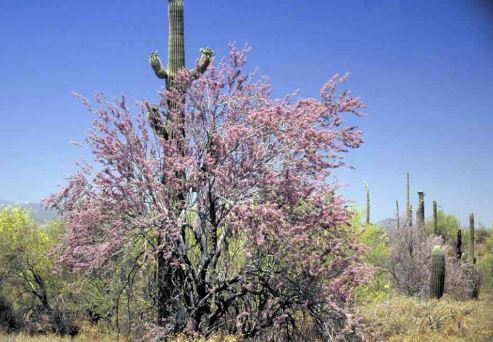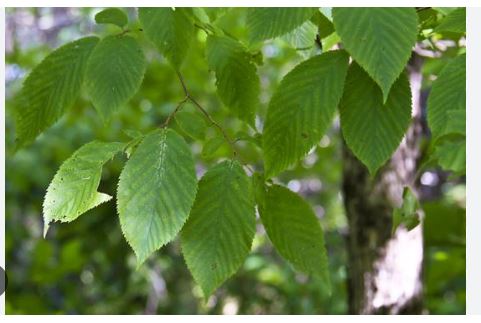
The Ironwood Tree, commonly referring to Olneya tesota in North American contexts, belongs to the Fabaceae family, which includes legumes like peas and acacias. The genus Olneya is monotypic, with O. tesota as its sole species, derived from the Greek word for “olive-like,” reflecting its fruit’s appearance.
Alternatively, “ironwood” may describe other species globally, such as Acacia estrophiolata in Australia or Carpinus caroliniana in eastern North America, but O. tesota, known as Desert Ironwood, is the focus here due to its prominence in arid regions. Taxonomically, it’s a woody legume, valued for its durability and ecological role, distinct within the Papilionoideae subfamily for its nitrogen-fixing capabilities.
Olneya tesota is a slow-growing, evergreen to semi-deciduous shrub or small tree, typically reaching 15–30 feet (4.5–9 meters) tall and wide, with a rounded, spreading canopy. Its gray-green, pinnate leaves, 1–2 inches (2.5–5 cm) long, consist of small, leathery leaflets, often shedding in drought to conserve water. The bark is dark gray, fissured, and exceptionally hard—hence the name “ironwood.”
From late spring to early summer, it produces clusters of pea-like, lavender-purple flowers, 0.5 inch (1.3 cm) long, followed by brown, woody pods, 1–2 inches (2.5–5 cm) long, containing 1–4 shiny, dark seeds. Spiny branches and a dense root system enhance its desert resilience, while its wood, sinking in water due to density, is prized for carving. Mature trees may live over 800 years.
Desert Ironwood is native to the Sonoran Desert, spanning southwestern Arizona, southeastern California, and northwestern Mexico (Sonora, Baja California). It thrives in sandy washes, rocky slopes, and alluvial plains below 3,000 feet (900 meters), often anchoring desert ecosystems as a nurse plant for cacti and shrubs.
Beyond its native range, it’s cultivated in arid regions of Nevada, Texas, and southern Utah for landscaping. While not invasive, its seeds are dispersed by animals, enabling modest natural spread within suitable habitats. Globally, it’s a symbol of desert resilience, rarely cultivated outside desert climates due to its specific water and heat needs.
Olneya tesota is hardy in USDA zones 8b–11, tolerating temperatures from 15°F to 110°F (-9°C to 43°C), though young plants are frost-sensitive below 25°F (-4°C). It thrives in hot, arid climates, ideal for desert regions like Tucson or Palm Springs. In zones 8b–9a, winter protection (e.g., frost cloth) aids establishment. Below zone 8b, it’s impractical outdoors, though container growth with indoor wintering is possible in bright, warm conditions (50–70°F/10–21°C). Its heat tolerance and low water needs make it a staple in xeriscapes within its range.
Desert Ironwood is a cornerstone of arid landscaping, valued for its sculptural form, shade, and ecological benefits. As a specimen tree, its gnarled branches and purple blooms create focal points in xeriscapes or desert gardens, while its canopy shelters smaller plants and wildlife, attracting birds and pollinators. Planted in groups, it forms windbreaks or naturalistic screens, growing 15–25 feet (4.5–7.5 meters) wide to define spaces. Its deep roots stabilize sandy soils, making it ideal for erosion control on slopes.
In courtyards or near patios, it offers filtered shade, though its spines require placement away from paths. Slow growth limits its use in quick-establishment projects, but its longevity and minimal irrigation needs make it sustainable for low-water, wildlife-friendly designs in desert climates.

How To Grow And Care For Ironwood Trees
Light Requirements
Provide full sun, with at least 8 hours of direct sunlight daily, to mimic its Sonoran Desert habitat and ensure robust growth. It thrives in open, unshaded areas, as even partial shade reduces flowering and weakens its structure. For container plants, place in the sunniest outdoor spot or near a south-facing window indoors.
Soil Preferences
Plant in well-draining, sandy or gravelly soil with a pH of 6.5–8.0, typical of desert washes. It tolerates poor, rocky soils but requires excellent drainage to prevent root rot. In containers, use a cactus or desert-plant mix with 50% sand or perlite, avoiding heavy, water-retentive soils.
Watering Needs
Water deeply but infrequently—1–2 inches (2.5–5 cm) every 2–3 weeks during the first two years to establish roots, allowing soil to dry completely between waterings. Once established, water monthly in summer, skipping winter unless drought persists. Overwatering causes weak growth or rot, so monitor soil carefully.
Temperature Range
Grow in USDA zones 8b–11, where temperatures range from 15°F to 110°F (-9°C to 43°C). Young trees are frost-sensitive below 25°F (-4°C); protect with frost cloth in zones 8b–9a. In colder zones, cultivate in pots and move indoors during winter, maintaining above 40°F (4°C) in bright conditions.
Humidity Levels
Prefer low humidity (10–30%), suited to desert climates. High humidity increases fungal risks, so ensure good air circulation, especially for potted or greenhouse plants. Avoid misting; dry air supports its leathery leaves and woody stems, replicating its arid native environment.
Container Selection
Choose large, deep pots with drainage holes, at least 18–24 inches (45–60 cm) wide, to accommodate its deep taproot and eventual size. Heavy terracotta or resin pots provide stability for its top-heavy canopy. Repot every 3–4 years to refresh soil, ensuring room for slow but steady growth.
Fertilization
Apply a low-nitrogen, slow-release fertilizer (e.g., 5-10-10 NPK) once in early spring to support modest growth without overstimulating foliage. Desert natives need minimal feeding; excess nutrients cause weak, sappy wood. In containers, use a diluted liquid fertilizer annually, avoiding applications in fall–winter.
Pruning
Prune sparingly in late winter to remove dead, damaged, or crossing branches, using clean, sharp loppers to shape its natural form. Avoid heavy cuts, as slow growth delays recovery. Trim lower branches for a tree-like appearance or to clear paths, noting spines require cautious handling.
Propagation
Propagate via seeds or cuttings, though seeds are more reliable. Soak seeds in warm water for 24 hours, then sow in a sandy mix at 75–85°F (24–29°C); germination takes 2–6 weeks. Hardwood cuttings, taken in spring, root slowly (8–12 weeks) with hormone treatment. Seeds need scarification for best results.
Pest Control
Monitor for pests like scale or spider mites, which may target stressed trees in hot, dry conditions. Inspect bark and leaves, treating infestations with neem oil or insecticidal soap in early morning. Maintain proper watering and avoid wounding to deter pests, as healthy ironwoods are naturally resilient.
Repotting
Repot container-grown trees every 3–4 years in early spring, or when roots crowd the pot. Gently remove, trim circling roots, and replant in fresh desert mix at the same depth. Water lightly after repotting, keeping in partial shade for two weeks to reduce shock, ensuring excellent drainage.
Winter Care
In zones 8b–9a, mulch the base with 2–3 inches (5–7.5 cm) of gravel or bark to insulate roots during cold snaps; cover young trees with frost cloth if freezes are forecast. Indoor potted trees need bright light, cool temperatures (40–50°F/4–10°C), and minimal watering to mimic dormancy.
Common Issues
Address overwatering (yellowing leaves, root rot) by improving drainage and reducing frequency. Underwatering (leaf drop, stunted growth) requires slight watering increases, especially for young trees. Poor flowering may indicate insufficient sun or immaturity, as trees bloom reliably only after 5–10 years. Mistletoe infestations, common in deserts, are managed by pruning affected branches.